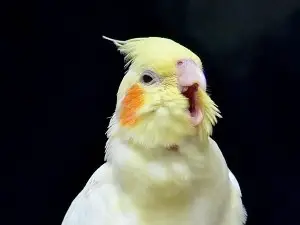
The cockatiel is one of the most popular pet birds, these birds are lovely when in healthy and good condition, and they look good too.
However, your bird’s looks can change and the bird may develop a growth on its beak sometime.
This article is a look into why your cockatiel has a growth on the side of its beak
Table of Contents
Cockatiel growth on the side of beak:
Birds of all types are susceptible to a variety of growths on all parts of their body, their beaks included. These growths usually develop because of some sort of ailment.
Here is why this may be happening with your bird:
Avian pox:
One reason why your bird may have a growth on the side of its beak may be that the bird has avian pox or avipoxvirus.
This disease can affect a variety of birds and it can cause tumor-like growths on a bird’s beak as well as on the legs, wings, head, or on other non-feathered parts of the bird’s body, especially the face, and legs.
The growths will be yellow, red, pink, or grey in color and your bird may develop one or a number of growths on its beak. These growths are pustules full of pus.
These don’t seem to be painful to the bird as the birds can go about their day feeding normally and moving around as though nothing is wrong but the growths can grow to be large enough that they stop birds from being able to eat or even being able to see.
Birds get this disease through touching contaminated surfaces, through biting insects (insects like flies, and mosquitoes) and the bird can also get this disease through contact with an infected bird.
What to do:
Taking your bird to the vet for a diagnosis is recommended, the vet will be able to determine if the bird does actually have this condition.
Your vet will recommend supportive care and will also prescribe antibiotics if your bird has a secondary infection in addition to having avian pox.
A tumor:
Another reason why your bird may have developed a growth on the side of its beak may be because the bird has a tumor growing on the side of its beak.
Tumors are solid masses of tissue that may or may not spread depending on whether they are benign (noncancerous) or malignant (cancerous).
They can also grow anywhere on your bird’s body including on the bird’s beak
What to do:
Taking your bird to the vet is the recommended solution in this case as well.
Your vet will be able to diagnose your bird and if the bird does have a tumor then the vet will also determine if it is benign (non-cancerous) or malignant (cancerous).
If your bird has a benign tumor then the tumor can be removed by the vet with no issue.
We don’t recommend that you try to cut the tumor off yourself as this can cause bleeding in your bird. These animals are small so a loss of too much blood can be fatal.
A malignant tumor may also be removed but the cancer cells may have spread to other parts of the birds body, your vet will be able to guide you on a way forward if this is the case.
If you enjoyed this article then you may also be interested in other bird related articles. Here are some articles that you may be interested in: Budgie Cere Hypertrophy, Budgie Cere Overgrowth, Why Is My Budgie’s Beak Dry?, How To Tell If Birds Are Bonded To Each Other, How To Know If A Parrot Is Angry, Why Are My Bird’s Feathers Turning Grey?, Black Feather Fungus, Black Spots On Cockatiel Feathers, Conure Feathers Turning Black

